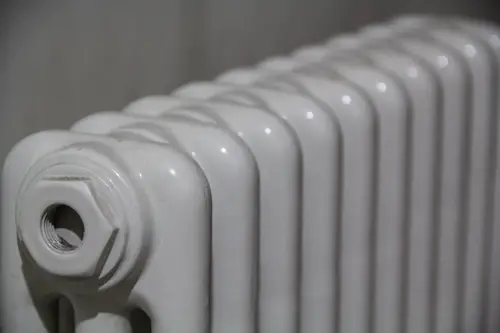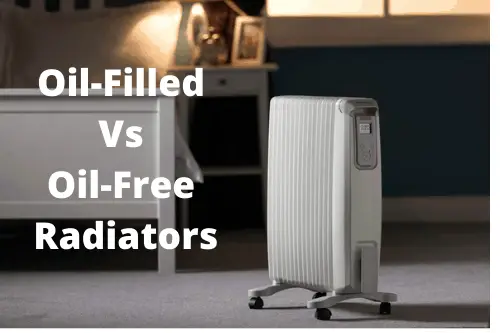A homeowner who understands the need for having a warm home, especially during the winter season, understands that there is a great need to purchase a heater. However, deciding to have a piece of heating equipment in your home is not the only obstacle you have to scale through. There is also the need to decide the best type of radiator that would work for you.

However, to buy a new radiator means, first of all, considering different options and factors, especially dealing with the all-important conundrum of choosing between oil-filled or oil-free radiators.
In light of that, we get why choosing between either radiator for your home is such a hard battle to face. As both oil-free and oil-filled radiators have a lot of beneficial and advantageous features that make it hard to comfortably and decisively pick one over the other.
Regardless, by the end of this guide, you will know all you need to about both radiators, how they work, as well as everything you need to finally make a decision between the two.
Oil-Free Radiators
Also known as dry thermal electric radiators, an oil-free radiator, as the name suggests is designed and made to utilise some of the most advanced heating technology available today, ensuring efficient, fast and careful heating throughout rooms, without making use of any oil.
Last update on 2025-01-24 / Images from Amazon Product Advertising API
To properly provide fast and efficient heat without utilising any oil, an oil-free radiator is designed to use dry thermal heating components instead, which is one of the most advanced areas of electric heating. Some examples of the dry thermal heating elements oil-free radiators utilise are aluminium and ceramic stones.
With all that in mind, the obvious factor to ponder on now is how it all works. Answering that, you should first of all note that the oil-free and oil-filled radiators don’t operate too differently, as it’s basically the same all-around process of radiation and convection[1]. However, let’s explain the oil-free radiator for now.
The oil-free radiator operation process is quite simple, as it is designed to use ceramic stones or other dry thermal heating components to create heat, as well as transfer the heat through a combination of convection. This process in turn then involves the transportation of heat around the room, whereby the heat is generated from the air coming in contact with the radiator.
In light of the process above, you should take note that oil-free radiators that use ceramic stones tend to heat up quite slowly, even though it has amazing thermal properties. In addition, an aluminium-based oil-free radiator is different from the former, based on the fact that they are more responsive and heat up very quickly.
Oil-Filled Radiators
Also referred to as thermal fluid electric radiators, the oil-filled radiator is the more traditionally known radiator type throughout the world.
Last update on 2025-01-24 / Images from Amazon Product Advertising API
An oil-filled radiator is obviously in contrast with an oil-free radiator and a simple look at the name will tell you why, as this radiator type makes use of a combination of electrical elements and oil to function.
However, you should note that the oil utilised by oil-filled radiators is called thermodynamic oil. Now, with the main operating aspects out of the way, let’s examine how an oil-filled radiator works. As is mentioned above, an oil-filled and oil-free radiator basically work with the same process of radiation and convection. The distinctive thing is that they use a combination of different components to carry out the said process.
In light of that, an oil-filled radiator works by combining its thermodynamic oil with the electrical elements it is designed with. Therefore, the oil-filled radiator heats up by immersing the inbuilt electrical elements in the specially designed thermodynamic oil. The thermodynamic oil then spreads heat across the radiator in an even manner, which begins the process of transferring heat into the metal, as well as emitting heat through radiation into the room.
By virtue of natural convection, the heat generated from the radiator is circulated around the room, as the air that passes against or comes in contact with the radiator is warmed up as well. This process speedily and efficiently heats up the entire room, sending the colder air to the bottom of the room to get heated by the radiator, as the warmer air rises to the top.
After learning the definition of the oil-free and oil-filled radiators and how they operate, you would notice that there’s a glaring similarity between the two. This is the operating process of both radiators, as they both operate a similar means of radiation and convection.
However, while they have other similarities like their main functions and certain benefits, they are also several differences, which can majorly be found in their distinct advantages. Therefore, it’s only right to look at it, in order to know which would be the best choice for your home.

The Advantages of Oil-Free Radiators
-
Fast Heating and Easy Control
An amazing aspect of oil-free radiators is that it is exceptionally quick when it comes to warming up or heating up your home. The reason for this is based on the main fact that it makes use of no oil in the first place, as you basically no longer need to wait for the oil to heat up.
Therefore, an oil-free radiator which makes use of dry thermal heating elements heats up a room faster than any other heating technology available. In addition, you also don’t need to wait for the oil to cool down, hence, an oil-free radiator also cools back down just as quick as it warms up. Now, this brings us to an added benefit based on this already established one, which is, the amazing and easy control you get.
Due to the fact that an oil-free radiator heats up and cools down quickly, you are assured easier control, as there is a rapid response to instructions. Also, because of the same rapid heating and cooling of the oil-free radiator, you get the ability to easily alter the temperature, ensuring you can get the right or ideal heat for your room.
Furthermore, by virtue of the functional capabilities that the radiator has, you have access to unequalled control, which goes a long way reducing your heating bills.
-
Easy to Use and Portable
At a time, a common complain about home heating technology from various consumers was the noise generated by the radiator, the heavy lifting needed to be done and such other similar hicks. However, an oil-free radiator basically solves all that, as it’s designed for easy and comfortable use.
For example, with an oil-free radiator, you don’t need to worry about any noise-generating as its running nor of any disturbance to your conversations or naps when its on. Apart from that, an added advantage is in that oil-free radiators which make use of dry thermal heating elements, especially aluminium tend to be lightweight.
This lightweight aspect of oil-free radiators makes them easier to move around for DIY installations or any other reasons. Also, you should note that a lot of oil-free radiators are made in a slimline design, which serves to make it stylish but most importantly to not occupy so much space in the room.
-
Suitable for High-Ceiling Homes
An aspect of the oil-free radiator that serves as an added advantage is that utilising ceramic stone or aluminium dry thermal components makes the oil-free radiator an excellent choice for large spaces or for households and properties that have high ceilings.
This is due to the fact that oil-free radiators push out or emit heat with such high intensity that they perfectly reach and heat up places that are usually too high up or hard to warm. Therefore, for properties such as Churches, open-plan offices and generally, homes with high ceilings, an oil-free radiator is highly beneficial and recommended.
-
Environmentally Friendly
An added bonus of an oil-free radiator that caters to certain people, that is, families or individuals who are environmentally conscious is that an oil-free radiator is environmentally friendly. This is because it makes use of no oils or any other substances that are or may be detrimental to the environment. Rather, oil-free radiators make use of dry thermal components, as week as electricity to heat up the surrounding air.
The Advantages of Oil-Filled Radiators
-
Self Sustainability
A benefit of an oil-filled radiator is one that is contrary to the popular belief that the oil-filled radiator has a major flaw, which is, the constant change of oil and continuous maintenance, you will have to do. However, that belief is quite wrong, as oil-filled radiators are amazingly self-sustainable.
This is because when utilizing an oil-filled radiator, you would never have to replenish or replace the oil inside the radiator. The reason for that is because the oil in the radiator simply serves as a means for absorption and the re-emission of heat. In addition, you won’t have to carry out any maintenance for the radiator at all, which makes it highly sustainable.
-
Outstanding Heat Retention
As mentioned above, the oil utilised by oil-filled radiators are thermodynamic oils and this is what gives us another benefit of oil-filled radiators. Now, the thing about thermodynamic oil is that they house amazing heat retention properties. Therefore, when compared to oil-free radiators, an oil-filled radiator has a whole lot more heat-retaining capabilities.
That is, once an oil-filled radiator heats up, they stay warmer for a lengthier period of time. Additionally, because of that fact, these type of heaters do not have to work that hard to keep or maintain the right or ideal temperature for your home. This aspect of oil-filled radiators further benefits the user, as it makes the heater energy efficient, as well as helps you save money on energy bills.
Also, you should note that oil-filled radiators will automatically turn off when it gets to your ideal temperature and you will still feel the warmth for a long time afterwards.
-
Uniform Distribution of Heat
You know how sometimes, heating technology like central heating can have cold spots, especially when you don’t maintain it regularly. Well, that isn’t the case with oil-filled radiators, as it spreads and distributes the heat uniformly and evenly.
The even distribution of heat that you can get from oil-filled radiators is as a result of the thermal fluid inside them being evenly spread along the entire surface area, as the radiator heats up. By virtue of that process, the heat will spread uniformly throughout the room.
Now, from those advantages given above, you can clearly gather the little differences that exist between both radiators. However, you should note that there are also similarities between the two, for example, they are both easy to install. With all that in mind, knowing which you should get shouldn’t be that difficult, but we will help out.
Which Radiator Should I Get?
In answering the above-stated question, you should first understand that the radiator you should get doesn’t solely depend on just the features of the radiator alone, but on other factors as well. The other factors that you ought to consider are factors surrounding your home or household, as well as your personal preferences.
Now, in regards to the former, you ought to take into consideration the design of your home, as well as the size of the room. Also, you should factor in your pockets as well, and determine which radiator type fits your budget.
However, in the view of this article, if you are to choose between an oil-free radiator or an oil-filled radiator, the oil-free radiator would be the right option. The reason for that is in the beneficial functions it has, which surpasses those of the oil-filled radiator by a little.
Glossary
[1] Convection – Link




